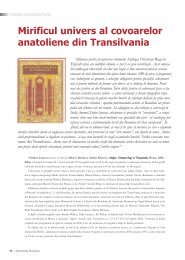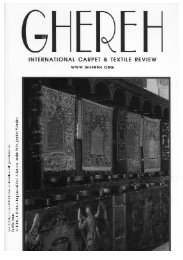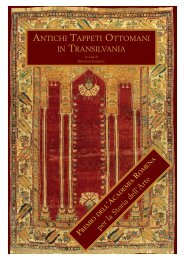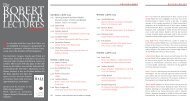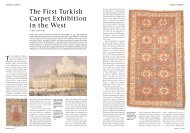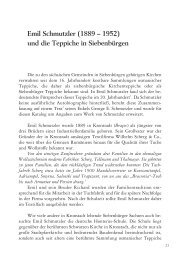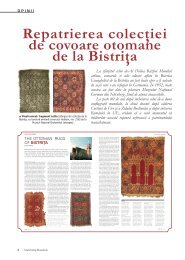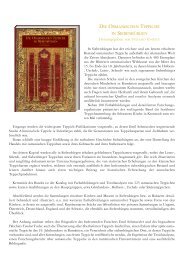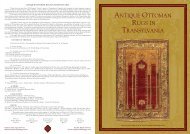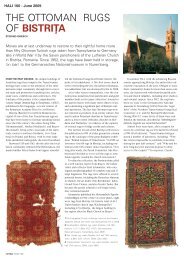139 Books pf - Antique Ottoman Rugs in Transylvania
139 Books pf - Antique Ottoman Rugs in Transylvania
139 Books pf - Antique Ottoman Rugs in Transylvania
Create successful ePaper yourself
Turn your PDF publications into a flip-book with our unique Google optimized e-Paper software.
ANTIQUE OTTOMAN RUGS IN TRANSYLVANIA | TRADITIONAL<br />
TEXTILES OF CAMBODIA | TIBETAN RUGS BOOKS<br />
Last Word on <strong>Transylvania</strong><br />
The mystery of so-called ‘<strong>Transylvania</strong>n’ rugs is expla<strong>in</strong>ed <strong>in</strong> a superb new book, <strong>Antique</strong><br />
<strong>Ottoman</strong> <strong>Rugs</strong> <strong>in</strong> <strong>Transylvania</strong>, written, compiled and published by Stefano Ionescu, with<br />
additional texts by Alberto Boralevi and Andrei Kertesz. Accord<strong>in</strong>g to Michael Franses, the<br />
book is beautifully produced, thoroughly researched, extremely well written, and a ‘musthave’<br />
for all rug libraries and carpet bibliophiles<br />
<strong>Antique</strong> <strong>Ottoman</strong> <strong>Rugs</strong><br />
<strong>in</strong> <strong>Transylvania</strong><br />
Alberto Boralevi, Stefano<br />
Ionescu & Andrei Kertesz<br />
Stefano Ionescu <strong>in</strong> association<br />
with Esselibri and Verduci<br />
Editore, Rome 2005<br />
228pp., 310 colour & 90 b/w<br />
illustrations, l<strong>in</strong>e draw<strong>in</strong>gs, maps,<br />
bibliography, technical analyses,<br />
<strong>in</strong>dex of published rugs<br />
ISBN 8876207070<br />
Standard Edition, 400 copies,<br />
hardbound with jacket, €150<br />
Limited Edition, 75 copies,<br />
numbered 11-85, hardbound<br />
with slipcase, €200<br />
<strong>Antique</strong> <strong>Ottoman</strong> <strong>Rugs</strong> <strong>in</strong> <strong>Transylvania</strong><br />
shows for the first time the importance<br />
of the German-speak<strong>in</strong>g<br />
Saxon Protestant communities<br />
<strong>in</strong> <strong>Transylvania</strong> (modern day<br />
western Romania) and their<br />
<strong>in</strong>terest <strong>in</strong> and enthusiasm for<br />
collect<strong>in</strong>g Anatolian carpets<br />
over a period of more than five<br />
hundred years. To achieve this,<br />
Stefano Ionescu has spent many<br />
years fully research<strong>in</strong>g every surviv<strong>in</strong>g<br />
rug <strong>in</strong> this region, as well<br />
as every archival document that<br />
refers to carpets.<br />
The results are impressive<br />
and the book (presently available<br />
<strong>in</strong> English and Italian editions,<br />
with a Romanian version<br />
<strong>in</strong> the pipel<strong>in</strong>e, and a German<br />
edition planned if demand<br />
warrants it) is a worthy successor<br />
to Emil Schmutzler’s<br />
Altorientalische Teppiche <strong>in</strong> Siebenbürgen<br />
(Leipzig 1933), which has,<br />
for seventy years, been the<br />
‘bible’ <strong>in</strong> this field.<br />
Introductory matter on early<br />
carpet studies is followed by discussion<br />
of the historical background<br />
to the so-called ‘<strong>Transylvania</strong>n’<br />
rug phenomenon, of<br />
the trade <strong>in</strong> oriental carpets to<br />
<strong>Transylvania</strong> and of the ways <strong>in</strong><br />
which the rugs were used and<br />
valued. The heart of the book is<br />
the colour catalogue itself, and<br />
f<strong>in</strong>ally there are a number of<br />
detailed appendices, <strong>in</strong>clud<strong>in</strong>g<br />
essays on Schmutzler (the most<br />
important collector of these<br />
types of rugs of his period, to<br />
whom <strong>Antique</strong> <strong>Ottoman</strong> <strong>Rugs</strong> <strong>in</strong><br />
<strong>Transylvania</strong> is dedicated), and<br />
Teodor Tuduc (the notorious<br />
dealer, restorer and forger<br />
whose name is so often associated<br />
with this k<strong>in</strong>d of rug). There<br />
is also a list of the donor <strong>in</strong>scriptions<br />
that appear on several<br />
of the rugs, a comprehensive<br />
list of locations, an <strong>in</strong>dex of<br />
published rugs, technical analyses<br />
and a full bibliography.<br />
The aim of the book project<br />
(see HALI 132, pp.52-57) has<br />
been to present “full up-to-date<br />
<strong>in</strong>formation, follow<strong>in</strong>g thorough<br />
research <strong>in</strong> the area, on about<br />
380 Turkish rugs from the <strong>Ottoman</strong><br />
period (late 15th to late<br />
18th century), still to be found<br />
<strong>in</strong> <strong>Transylvania</strong>”, which “constitute<br />
at the same time the most<br />
important heritage of Turkish<br />
art <strong>in</strong> this part of Europe”. Over<br />
250 antique <strong>Ottoman</strong> rugs are<br />
illustrated <strong>in</strong> colour, with 225 <strong>in</strong><br />
the pr<strong>in</strong>cipal catalogue section.<br />
Almost all of these still rema<strong>in</strong><br />
<strong>in</strong> churches and museums <strong>in</strong><br />
<strong>Transylvania</strong> (apart from a few<br />
<strong>in</strong> other museums elsewhere <strong>in</strong><br />
Romania, Hungary and Austria,<br />
and some from the Schmutzler<br />
and Bistrita collections). All but<br />
one were made <strong>in</strong> Anatolia.<br />
<strong>Ottoman</strong> double-niche rug, west<br />
Anatolia, second half 17th century.<br />
1.22 x 1.63m (4'0" x 5'4"). Formerly<br />
Evangelical Parish Church, Sibiu, now<br />
Brukenthal Museum, Sibiu, M.2214<br />
Follow<strong>in</strong>g the author’s term<strong>in</strong>ology,<br />
the pr<strong>in</strong>cipal catalogue<br />
<strong>in</strong>cludes two ‘Ghirlandaio’<br />
(diamond-medallion)<br />
rugs, five ‘Holbe<strong>in</strong>s’ (‘smallpattern’,<br />
with alternat<strong>in</strong>g diagonal<br />
rows of <strong>in</strong>terlaced medallions<br />
and diamond-shaped<br />
medallions), three eight-lobed<br />
star Ushaks, two ‘T<strong>in</strong>torettos’<br />
(small-medallion Ushaks), one<br />
‘Bell<strong>in</strong>i’ (re-entrant or ‘keyhole’),<br />
32 ‘Lottos’ (arabesque)<br />
and one hexagonal star design<br />
rug. There are twenty whiteground<br />
rugs from the town of<br />
Selendi, <strong>in</strong>clud<strong>in</strong>g seven with the<br />
ç<strong>in</strong>tamani pattern, eleven ‘bird’<br />
and two ‘scorpion’ rugs. There<br />
are 147 (plus a further 18 among<br />
the additional illustrations) that<br />
are specifically identified as<br />
belong<strong>in</strong>g to the so-called ‘<strong>Transylvania</strong>n’<br />
group, <strong>in</strong>clud<strong>in</strong>g 71<br />
double-niche rugs, five s<strong>in</strong>gleniche<br />
rugs, 42 other prayer rugs<br />
and 29 rugs with columns (one<br />
of which, a coupled-column<br />
prayer rug, was made <strong>in</strong> Cairo).<br />
F<strong>in</strong>ally, there are some other<br />
Anatolian types – all but one<br />
of them prayer rugs – that are<br />
specifically attributed to towns<br />
<strong>in</strong> Anatolia (four to Gördes, five<br />
to Kula and two to Karap<strong>in</strong>ar).<br />
My only real criticism of the<br />
book concerns term<strong>in</strong>ology,<br />
because this has been, and con-<br />
HALI <strong>139</strong> I 55
BOOKS<br />
t<strong>in</strong>ues to be, the cause of much<br />
confusion. When applied to<br />
rugs the term ‘<strong>Transylvania</strong>n’<br />
has always been confus<strong>in</strong>g to<br />
non-experts, not least because<br />
it has been used <strong>in</strong> two different<br />
ways. It has been applied generally<br />
to all the Anatolian rugs<br />
that have survived <strong>in</strong> churches<br />
<strong>in</strong> the part of eastern Europe<br />
loosely called ‘<strong>Transylvania</strong>’. It<br />
has also been used to identify a<br />
specific group of rugs of similar<br />
technique and designs that form<br />
a significant part of the surviv<strong>in</strong>g<br />
rugs <strong>in</strong> <strong>Transylvania</strong>n collections.<br />
Further confusion has<br />
been caused by occasional misguided<br />
and fanciful attempts to<br />
demonstrate that some, if not<br />
all, of these rugs were actually<br />
made <strong>in</strong> eastern Europe. There<br />
is ample evidence, both historical<br />
and technical, to show that<br />
these rugs were produced <strong>in</strong><br />
western Anatolia, <strong>in</strong>clud<strong>in</strong>g<br />
documentary evidence <strong>in</strong> <strong>in</strong>ventories<br />
and customs documents<br />
record<strong>in</strong>g their importation<br />
from Anatolia.<br />
The contributors to <strong>Antique</strong><br />
<strong>Ottoman</strong> <strong>Rugs</strong> <strong>in</strong> <strong>Transylvania</strong> have,<br />
for the most part, used traditional<br />
nomenclature for the attribution<br />
of carpets. Giv<strong>in</strong>g names<br />
to specific patterns undoubtedly<br />
aids the communication of ideas,<br />
and the practice of nam<strong>in</strong>g a<br />
pattern after a Western pa<strong>in</strong>ter<br />
who depicts an appropriate rug<br />
<strong>in</strong> his work is certa<strong>in</strong>ly both<br />
Above: Spread from <strong>Antique</strong> <strong>Ottoman</strong><br />
<strong>Rugs</strong> <strong>in</strong> <strong>Transylvania</strong> show<strong>in</strong>g prayer<br />
rugs and religious pa<strong>in</strong>t<strong>in</strong>gs <strong>in</strong> the<br />
Black Church, Brasov, and four 17th<br />
century Turkish prayer rugs from<br />
the Black Church and the Brukenthal<br />
Museum, Sibiu<br />
Right: <strong>Ottoman</strong> double-niche rug,<br />
west Anatolia, late 17th century.<br />
1.30 x 1.73m (4'3" x 5'8"). Monastery<br />
Church Sighişoara, 1014<br />
charm<strong>in</strong>g and useful. So ‘keyhole’<br />
rugs are known as ‘Bell<strong>in</strong>is’<br />
and small-medallion Ushaks as<br />
‘T<strong>in</strong>torettos’. In this ve<strong>in</strong>, perhaps<br />
we should name the traditional<br />
eight-lobed star Ushak<br />
design ‘Paris Bordone’.<br />
However, such labell<strong>in</strong>g is<br />
often done with too little<br />
thought and I myself have to<br />
some extent been guilty of this.<br />
It is the lack of a clear def<strong>in</strong>ition<br />
from the outset that leads<br />
to misunderstand<strong>in</strong>g. For example,<br />
<strong>in</strong> the section on ‘Ghirlandaio<br />
<strong>Rugs</strong>’, Alberto Boralevi<br />
illustrates a fabulous mid-15th<br />
century rug <strong>in</strong> the Evangelical<br />
Church <strong>in</strong> Halchiu (cat.1; HALI<br />
137, p.53). The field has a yellow<br />
ground with two rectangular<br />
compartments, <strong>in</strong> each of which<br />
is a large segmented diamond<br />
medallion. Boralevi demonstrates<br />
the similarity of this to<br />
the rug depicted <strong>in</strong> Domenico<br />
Ghirlandaio’s glorious Madonna<br />
Enthroned with Child and Sa<strong>in</strong>ts<br />
(1480-85), now <strong>in</strong> the Uffizi<br />
Gallery <strong>in</strong> Florence, which he<br />
illustrates opposite. He expla<strong>in</strong>s<br />
that this diamond-medallion<br />
design can also be seen <strong>in</strong> some<br />
later rugs. He arrives at the date<br />
of the rug by compar<strong>in</strong>g it, correctly<br />
<strong>in</strong> my op<strong>in</strong>ion, to three<br />
of the most famous Anatolian<br />
‘animal’ rugs, the Marby rug <strong>in</strong><br />
the National Museum, Stockholm,<br />
the Von Bode dragon and<br />
phoenix rug <strong>in</strong> the Islamic Museum,<br />
Berl<strong>in</strong> and the Cagan animal<br />
rug <strong>in</strong> the Metropolitan<br />
‘TRANSYLVANIAN’<br />
RUGS ON THE<br />
MARKET<br />
HALI’s records show that<br />
between 1990 and the present,<br />
at least 44 ‘<strong>Transylvania</strong>n’<br />
rugs were sold at<br />
public auction at eleven<br />
lead<strong>in</strong>g auction houses<br />
(Bonhams, London; Brunk,<br />
Asheville; Bukowski, Stockholm;<br />
Christie’s, London;<br />
Christie’s, New York; Koller,<br />
Zurich; Nagel, Stuttgart;<br />
Rippon Boswell, Wiesbaden;<br />
Sk<strong>in</strong>ner, Bolton; Sotheby’s,<br />
London; Sotheby’s, New<br />
York) at prices rang<strong>in</strong>g between<br />
$4,000 and $104,000.<br />
This is, of course, by no<br />
means a comprehensive<br />
record of all ‘<strong>Transylvania</strong>n’<br />
rugs sold <strong>in</strong> recent times.<br />
Many examples have not<br />
been listed, either because<br />
they were <strong>in</strong> poor condition<br />
and sold for very little,<br />
or because they rema<strong>in</strong>ed<br />
unsold, while many others<br />
have been sold privately,<br />
off the record. The best of<br />
the rugs at auction were<br />
generally <strong>in</strong> poorer condition<br />
and of lesser quality<br />
than some of those illustrated<br />
<strong>in</strong> gallery catalogues<br />
and advertisements.<br />
Over the years, I have<br />
seen several hundred related<br />
rugs <strong>in</strong> Western collections.<br />
Most are <strong>in</strong> a used<br />
condition, but I have seen<br />
at least ten that are prist<strong>in</strong>e<br />
and I have always thought<br />
that these might orig<strong>in</strong>ally<br />
have come from <strong>Transylvania</strong>n<br />
churches. In discussion<br />
with Stefano Ionescu, however,<br />
he has suggested that<br />
virtually all the rugs that<br />
were <strong>in</strong> <strong>Transylvania</strong> <strong>in</strong><br />
Emil Schmutzler’s time<br />
rema<strong>in</strong> there today, apart<br />
from those removed from<br />
Bistrita dur<strong>in</strong>g the Second<br />
World War, which are still<br />
<strong>in</strong> the German National<br />
Museum <strong>in</strong> Nuremberg. He<br />
expla<strong>in</strong>ed to me that not all<br />
the Saxon peoples of <strong>Transylvania</strong><br />
gave their rugs to<br />
churches, and some kept<br />
them at home. A number of<br />
such rugs might have left<br />
the region with the exodus<br />
of German-speakers dur<strong>in</strong>g<br />
the communist period. MF<br />
56 I HALI <strong>139</strong>
BOOKS<br />
Museum, New York. These three<br />
are possibly from the same area<br />
as the Halchiu rug, but have<br />
very different field patterns.<br />
If we are to use a term such<br />
as ‘Ghirlandaio’ it should be<br />
expla<strong>in</strong>ed more clearly. Here<br />
it signifies not a specific weav<strong>in</strong>g<br />
type but a particular design<br />
feature. Any author should<br />
def<strong>in</strong>e precisely the terms he<br />
adopts, po<strong>in</strong>t<strong>in</strong>g out all the<br />
features used to identify rugs<br />
under such a label, if the subject<br />
is to be accessible to the<br />
lay reader. For example, an 18th<br />
century rug <strong>in</strong> the Evangelical<br />
Church <strong>in</strong> C<strong>in</strong>cu (cat.15) is<br />
labelled ‘Ghirlandaio’ but<br />
lacks the compartments. Are<br />
they not essential for this label?<br />
Other rugs from the end of the<br />
15th century have a similar<br />
design, and there are examples<br />
with a similar medallion but<br />
without compartments, for<br />
<strong>in</strong>stance a multiple-medallion<br />
rug <strong>in</strong> the Islamic Museum,<br />
Berl<strong>in</strong>. Are some or all of these<br />
also ‘Ghirlandaios’?<br />
‘Holbe<strong>in</strong>’ and ‘Lotto’ rugs <strong>in</strong> St<br />
Margaret’s Church, Mediaş<br />
My pr<strong>in</strong>cipal criticism of the<br />
term<strong>in</strong>ology – and aga<strong>in</strong> I have<br />
been guilty of this myself –<br />
comes with the cont<strong>in</strong>ued use<br />
of ‘<strong>Transylvania</strong>n’ as a label for<br />
a specific group of rugs. The term<br />
has caused confusion for more<br />
than seventy years, not only<br />
among lay readers but also<br />
among so-called ‘experts’, and<br />
it is time to elim<strong>in</strong>ate it. The<br />
so-called ‘<strong>Transylvania</strong>n’ type<br />
(s<strong>in</strong>gle-niche, double-niche,<br />
prayer or column) comprises<br />
examples that can be attributed<br />
to a small, but as yet unidentified,<br />
region <strong>in</strong> western Anatolia,<br />
perhaps centred <strong>in</strong> villages not<br />
far from Izmir (Smyrna), Ushak,<br />
Kula, Gördes and Milas. After<br />
read<strong>in</strong>g <strong>Antique</strong> <strong>Ottoman</strong> <strong>Rugs</strong> <strong>in</strong><br />
<strong>Transylvania</strong> I am determ<strong>in</strong>ed<br />
that <strong>in</strong> future I will not use this<br />
highly mislead<strong>in</strong>g term.<br />
On a related po<strong>in</strong>t, the section<br />
<strong>in</strong> the catalogue that attributes<br />
ten rugs specifically to Kula,<br />
Gördes, and Karap<strong>in</strong>ar (nos.216-<br />
225, plus no.14) only adds to the<br />
confusion. I do not question<br />
that these rugs may have been<br />
made <strong>in</strong> the Gördes, Kula or<br />
Konya (rather than Karap<strong>in</strong>ar)<br />
regions, but other rugs of the<br />
author’s so-called ‘<strong>Transylvania</strong>n’<br />
group were also, <strong>in</strong> all likelihood,<br />
made <strong>in</strong> these places.<br />
I might take issue with one<br />
further small po<strong>in</strong>t. The author<br />
writes that the group of rugs<br />
surviv<strong>in</strong>g <strong>in</strong> <strong>Transylvania</strong> is<br />
“undoubtedly the richest, bestpreserved<br />
and most representative<br />
ensemble of small Turkish<br />
rugs <strong>in</strong> the world”. This needs<br />
qualification. Undoubtedly the<br />
32 ‘Lottos’, the twenty Selendi<br />
rugs and the 147 so-called ‘<strong>Transylvania</strong>ns’<br />
each form the largest<br />
surviv<strong>in</strong>g body of their type<br />
<strong>in</strong> the world. However, while<br />
the Turkish and Islamic Arts<br />
Museum <strong>in</strong> Istanbul (TIEM), for<br />
example, may have only one or<br />
two examples of the ‘<strong>Transylvania</strong>n’<br />
group, its hold<strong>in</strong>gs give<br />
a much more comprehensive<br />
overview of Anatolian rugs of<br />
the period before 1800. While<br />
this book certa<strong>in</strong>ly publishes a<br />
full account of <strong>Ottoman</strong> rugs <strong>in</strong><br />
<strong>Transylvania</strong>, readers should<br />
not th<strong>in</strong>k that all extant types<br />
of classical period Anatolian<br />
rugs are represented.<br />
None of these issues however<br />
detract from the importance<br />
of this publication. There<br />
are very few oriental carpet<br />
books that are as well researched<br />
and as well produced as<br />
<strong>Antique</strong> <strong>Ottoman</strong> <strong>Rugs</strong> <strong>in</strong> <strong>Transylvania</strong>.<br />
Rarely does an author<br />
fulfil all his aims, but this is just<br />
such a case. I highly recommend<br />
that you acquire a copy, read it<br />
and enjoy it – I certa<strong>in</strong>ly did.<br />
Traditional Textiles of<br />
Cambodia. Cultural Threads<br />
and Material Heritage<br />
Gillian Green<br />
River <strong>Books</strong>, Bangkok 2003<br />
320 pp., 334 colour & b/w<br />
illustrations, maps and<br />
diagrams, notes, appendices,<br />
bibliography, <strong>in</strong>dex<br />
ISBN 9748225399<br />
Hardbound $50<br />
This is the first substantial book<br />
to focus exclusively on Cambodian<br />
textiles. It provides an important<br />
addition, attractively presented<br />
and sumptuously illustrated,<br />
to our knowledge of the rich<br />
textile arts of Southeast Asia.<br />
Gillian Green discusses the<br />
mak<strong>in</strong>g, mean<strong>in</strong>g and function<br />
of textiles <strong>in</strong> Cambodia as far as<br />
can be gleaned from historical<br />
and ethnographic sources. The<br />
evidence of surviv<strong>in</strong>g textiles<br />
only takes her back to the mid-<br />
19th century, when some Cambodian<br />
textiles were <strong>in</strong>cluded<br />
<strong>in</strong> the ‘Gifts of Mutual Respect’<br />
sent by Siamese k<strong>in</strong>gs to American<br />
presidents (these survive to<br />
this day <strong>in</strong> the Smithsonian Institution).<br />
More extensive <strong>in</strong>formation<br />
rema<strong>in</strong>ed scant until<br />
the 1920s, when anthropological<br />
and social researchers began to<br />
record the production of some<br />
Cambodian textiles, <strong>in</strong>clud<strong>in</strong>g<br />
their function on both religious<br />
and secular occasions.<br />
This relatively short period<br />
of accessibility came to an end<br />
with the Vietnam War, the devastation<br />
caused by the Khmer<br />
Rouge regime, and the diaspora<br />
of so many Cambodian citizens.<br />
Although sound scholarly work<br />
was done dur<strong>in</strong>g those few decades<br />
between about 1920 and<br />
1970, the study of Cambodian<br />
textiles never ga<strong>in</strong>ed the attention<br />
that the medium received<br />
at the same time <strong>in</strong> Indonesia.<br />
Green therefore faced a difficult<br />
task when it came to establish<strong>in</strong>g<br />
detailed historical and<br />
ethnographic background for<br />
her material. The book is largely<br />
based on a Master’s thesis at the<br />
Australian National University,<br />
which implies some limits on<br />
field work opportunities and<br />
primary research. The study does<br />
have the strength of a sound<br />
survey, but it does not present<br />
the <strong>in</strong>-depth cultural analysis<br />
that long-term immersion <strong>in</strong> a<br />
local community would have<br />
produced. This is a neutrally<br />
stated fact, not a criticism of<br />
the author’s efforts. But <strong>in</strong> any<br />
case it rema<strong>in</strong>s doubtful to what<br />
extent a study of ‘traditional’<br />
forms of Cambodian textiles<br />
could have been undertaken<br />
after the human and cultural<br />
destruction of the second half<br />
of the 2oth century.<br />
Green provides a well-structured<br />
and very readable account<br />
of the early history and 20th<br />
century role of textiles <strong>in</strong> Cambodian<br />
society. Her <strong>in</strong>troduction<br />
to the region and its people is<br />
especially to be commended for<br />
its emphasis on the country’s<br />
ethnic and religious diversity.<br />
Her ma<strong>in</strong> focus is of course on<br />
the Khmer population, but she<br />
also presents the role of Ch<strong>in</strong>ese<br />
and Islamic groups, the<br />
latter represented specifically<br />
by the Cham and Malays <strong>in</strong><br />
Cambodia. Malay <strong>in</strong>fluence on<br />
textile patterns and functions<br />
is referred to throughout the<br />
volume.<br />
The political and cultural<br />
relationship between the Khmer<br />
rul<strong>in</strong>g class and its neighbours<br />
<strong>in</strong> Siam is briefly explored <strong>in</strong><br />
the chapters on Khmer dress<br />
and textile history and, with<br />
reference to technical variations<br />
and dist<strong>in</strong>ctions, <strong>in</strong> the chapters<br />
dedicated to the production<br />
process. It would be valuable to<br />
HALI <strong>139</strong> I 57



